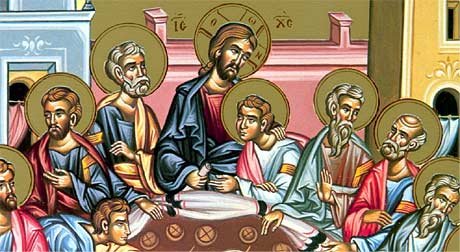In the last issue of this article, I began sharing a description of the Liturgy as contained in the Apostolic Constitutions. The first part consisted of the vesting of the Bishop, the readings, the sermons and then the dismissal of those who were not yet baptized. Once the potential converts were dismissed and only the faithful were left, they were invited to pray. The first prayer consisted in a comprehensive litany for the whole Church. Each of the petitions was responded to by the faithful with the words: Lord have mercy. This is the same as our present day Great Litany or Litany of Peace which now begins our Liturgy. The litany then and now ends with a prayer for the people. This form of dialogic prayer is characteristic of the Byzantine ritual. It appears first in the fourth century and does not necessarily have an equivalent type of prayer in the Judaic, synagogue ritual.
After the litany, the prayers of the faithful was then proclaimed by the bishop who extended the Peace of God to all. The people responded, as they still do today, with And with your spirit.
After this greeting the Kiss of Peace was then exchanged much in the manner that we have reintroduced it. For a long time in the Ukrainian Greek-Catholic Liturgy the Kiss of Peace was only exchanged between the clergy if there were priests who were concelebrating or when the bishop celebrates. The reintroduction of the Kiss of Peace is very appropriate. By the fourth century the kiss had come to be linked with the Eucharist itself rather than with the end of the Liturgy of the Word. It now properly prepares us for the declaration of the Creed, that statement of our deepest beliefs. It wonderfully declares an absolute prerequisite for our proclamation of our faith: Let us truly love one another so that we might profess: the Father, Son and Holy Spirit Who are One in substance and truly undivided. This simple prayer professes our faith in a Triune God. It is repeated at the very beginning of the Anaphora.
Before the beginning of the Anaphora, originally, the main concelebrant washed his hands. This action is still present in the Liturgy as a bishop celebrates. It was one of the earliest symbolic additions to the service. Jews customarily washed their hands before prayer, and Christians continued this practice until it fell into disuse when a bishop is not present.
The Anaphora, the central core of the Eucharist Liturgy, begins with a stern exhortation: Let us stand aright. Let us stand in awe. Let us be attentive to offer the Holy Oblation in peace. It is critical that we are attentive to this central part of the Divine Liturgy. At the beginning it also tells us to Lift up our hearts!
